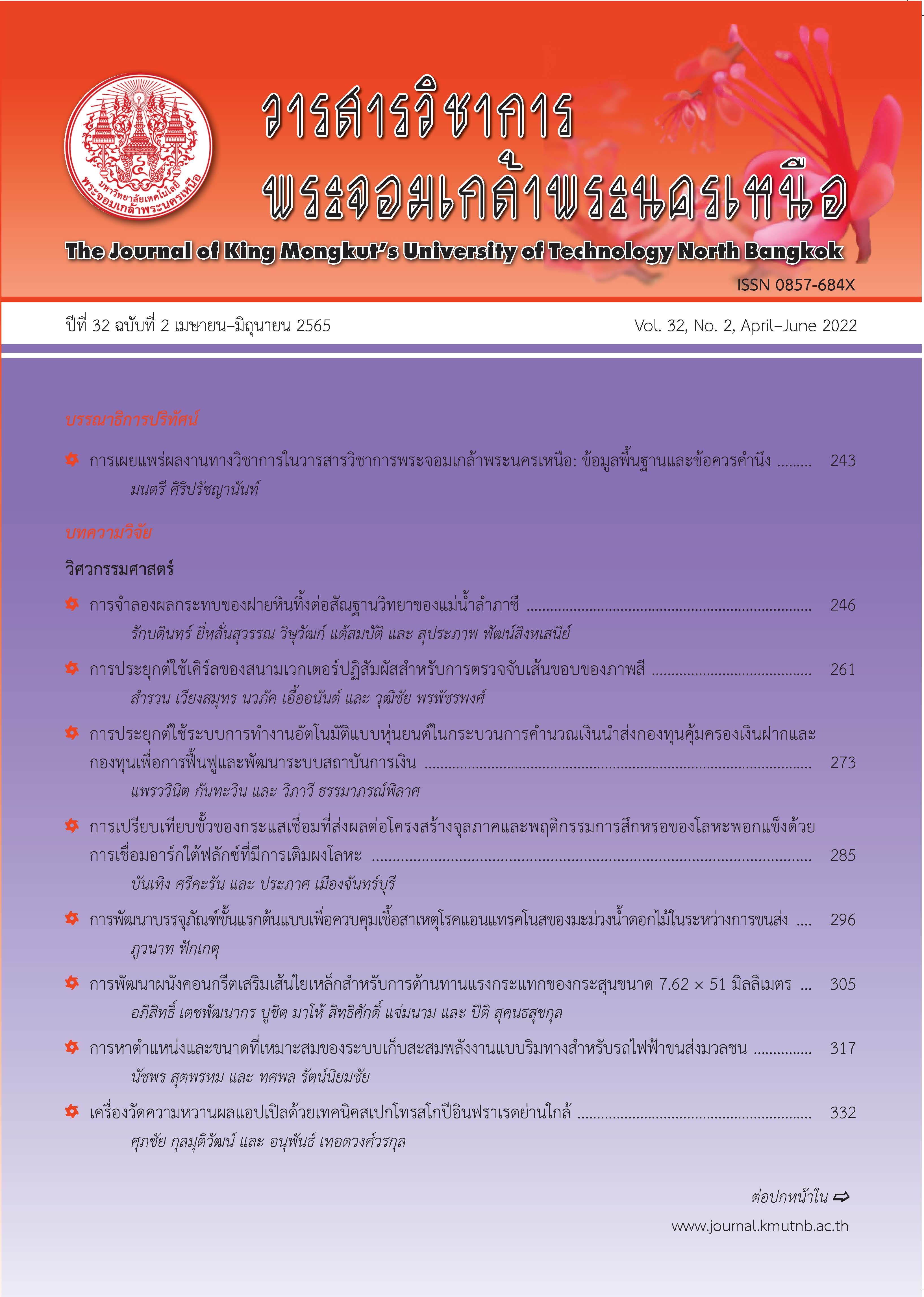ปริมาณคลอไรด์ทั้งหมดวิกฤต ระยะเวลาการเริ่มเกิดสนิมของเหล็กเสริมและกำลังอัดของคอนกรีตที่ผสมเถ้าลอยและใช้เถ้าก้นเตาแทนที่บางส่วนของมวลรวมละเอียด
Main Article Content
บทคัดย่อ
บทความนี้มุ่งศึกษาปริมาณคลอไรด์ทั้งหมดวิกฤต ระยะเวลาเริ่มเกิดสนิมของเหล็กเสริมและกำลังอัดของคอนกรีตที่ผสมเถ้าลอยและใช้เถ้าก้นเตาแทนที่มวลรวมละเอียดบางส่วน โดยใช้ซีเมนต์ปอร์ตแลนประเภทที่ 1 เป็นวัสดุประสานหลัก อัตราส่วนการแทนที่วัสดุประสานด้วยเถ้าลอยเท่ากับ 0.30 อัตราส่วนการแทนที่มวลรวมละเอียดด้วยเถ้าก้นเตาเท่ากับ 0.10, 0.20 และ 0.30 ทำการควบคุมค่ายุบตัวของคอนกรีตสดที่ 10±1 เซนติเมตร ตัวอย่างคอนกรีตถูกบ่มในน้ำหรือบ่มอากาศจนอายุ 28 วันก่อนเริ่มทดสอบเพื่อศึกษาผลกระทบของชนิดการบ่ม จากการผลการทดลองพบว่า คอนกรีตที่ผสมเถ้าลอยร้อยละ 30 ร่วมกับเถ้าก้นเตาร้อยละ 10 มีปริมาณคลอไรด์ทั้งหมดวิกฤตมากที่สุดและระยะเวลาการเริ่มเกิดสนิมของเหล็กเสริมที่นานที่สุด นอกจากนี้พบว่า คอนกรีตที่ผสมเถ้าก้นเตาร้อยละ 10 มีกำลังอัดสูงที่สุดที่อายุ 28 วัน และคอนกรีตที่บ่มน้ำมีปริมาณคลอไรด์ทั้งหมดวิกฤต ระยะเวลาการเริ่มเกิดสนิมและกำลังอัดที่สูงกว่าคอนกรีตที่บ่มอากาศ
Article Details

อนุญาตภายใต้เงื่อนไข Creative Commons Attribution-NonCommercial-NoDerivatives 4.0 International License.
บทความที่ลงตีพิมพ์เป็นข้อคิดเห็นของผู้เขียนเท่านั้น
ผู้เขียนจะต้องเป็นผู้รับผิดชอบต่อผลทางกฎหมายใดๆ ที่อาจเกิดขึ้นจากบทความนั้น
เอกสารอ้างอิง
C. S. Poon, S. C. Kon, and L. Lam, “Compressive strength chloride diffusivity and pore structure of high performance metakaolin and silica fume concrete,” Construction and Building Materials, vol. 20, no. 1, pp. 858–865, 2006.
U. Kunmongkol, T. Sumranwanich, P. Choktaweekarn, and S. Tangtermsirikul, “Rapid chloride penetration resistance of concrete containing fly ash and bottom ash from Mae Moh and Rayong,” in proceedings The 17th National Convention on Civil Engineering, Udon Thani, Thailand, 2012 (in Thai).
S. Arttamart, T. Sumranwanich, P. Sancharoen, and T. Chuosavasdi, “Chloride penetration resistance and compressive strength of concrete with fly ash and partial replacement of fine aggregate by bottom ash,” in proceedings The 1st KU SRC Annual Conference, Chonburi, 2016 (in Thai).
S. Namjan, T. Sumranwanich, and W. Saengsoy, “Chloride penetration resistance and compressive strength of concrete with bottom ash as partially sand replacement under marine environment,” in proceedings The 11th Annual Concrete Conference, Nakhon Ratchasima, 2016 (in Thai).
R. Kasemchaisiri and S. Tangtermsirikul, “A method to determine water retainability of porous fine aggregate for design and quality control of fresh concrete,” Construction and Building Materials, vol. 21, no. 6, pp. 1322–1334, 2007.
Standard Test Method for Half-Cell Potentials of Uncoated Reinforcing Steel in Concrete, American Society for Testing and Materials, ASTM C876, 2009.
Standard Test Method for Determining the Effects of Chemical Admixture on Corrosion of Embedded Steel in Concrete Exposed Chloride Environments, American Society for Testing and Materials, ASTM G109, 2013.
Standard Test Method for Acid-Soluble Chloride in Mortar and Concrete, American Society for Testing and Materials, ASTM C1152, 2012.
K. Hussain, P. Choktaweekarn, W. Saengsoy, T. Srichan, and S. Tangtermsirikul, “Effect of cement types, mineral admixtures, and bottom ash on the curing sensitivity of concrete,” International Journal of Minerals, Metallurgy and Materials, vol. 20, no. 1, pp. 94–105, 2013.
I. Yüksel, T. Bilir, and Ö. Özkan “Durability of concrete incorporating non-ground blast furnace slag and bottom ash as fine aggregate,” Building and Environment, vol. 42, no. 7, pp. 2651–2659, 2007.
K. Hussain, P. Choktaweekarn, and S. Tangtermsirikul “Effect of bottom ash and mineral admixtures on the curing sensitivity of concrete,” Research and Development Journal of the Engineering Institute of Thailand, vol. 22, no. 4, pp. 25–33, 2011 (in Thai).

